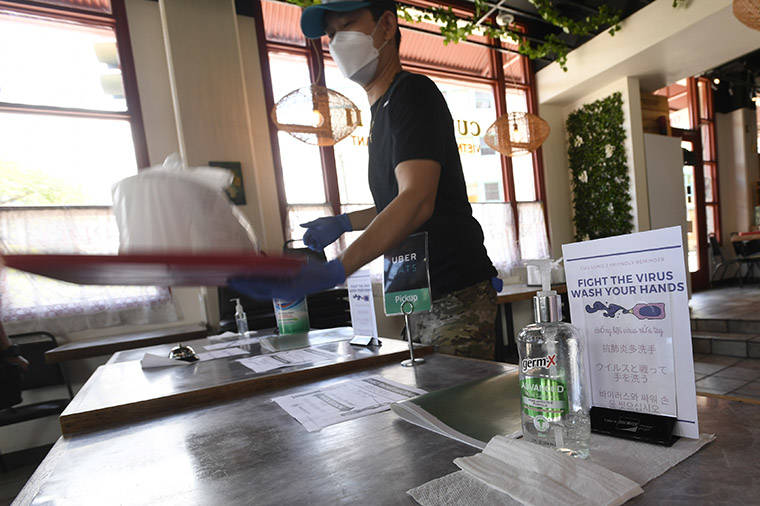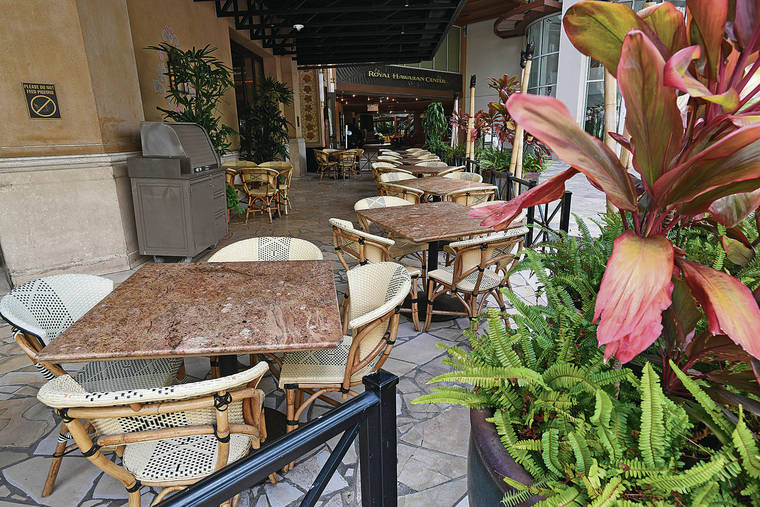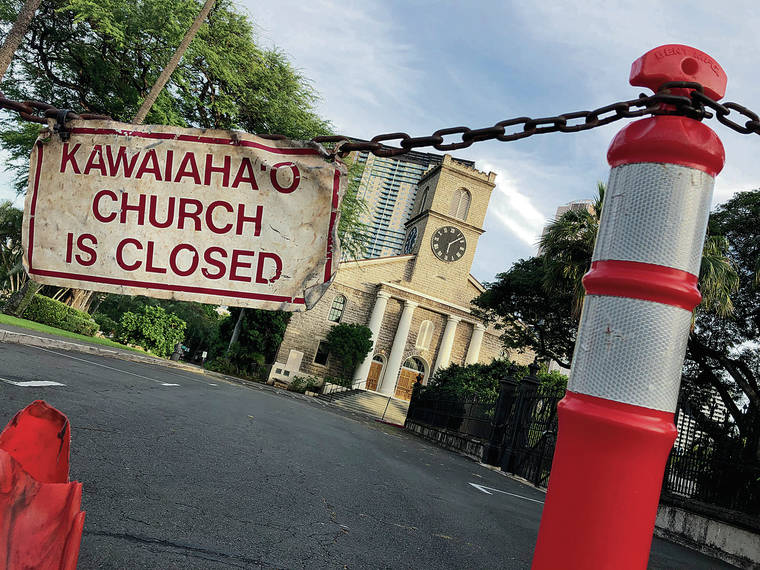Oahu restaurants and churches prepare to open their doors with social distancing rules in place


BRUCE ASATO / BASATO@STARADVERTISER.COM
Joey Nguyen, manager of Cuu Long II Vietnamese Restaurant on North Hotel Street in Chinatown, prepares an order for an Uber Eats driver on April 17. Gov. David Ige has approved guidelines for allowing indoor dining in restaurants and churches services on Oahu.

BRUCE ASATO / BASATO@STARADVERTISER.COM
The outdoor lanai seating area of The Cheesecake Factory at the Royal Hawaiian Center is closed, although takeout service continues to be offered.

GEORGE F. LEE / MARCH 29
Some churches will reopen Saturday. Many have streamed their services online. Kawaiaha‘o Church at King and Punchbowl streets has been closed since March and is set to reopen soon.




Oahu restaurants will be allowed to reopen for indoor dining on June 5 and churches will be able to resume in-person services with restrictions on Saturday under a new emergency order signed by Honolulu Mayor Kirk Caldwell.
The restaurant and church guidelines were approved by Gov. David Ige after the mayor submitted proposals for the reopening of what are considered medium-risk businesses. The proposed dates for other businesses weren’t released.
Restaurants must adhere to social distancing rules with group dining limited to 10 people and seating arranged with six feet of separation between groups. Customers and employees that interact with them must wear face coverings, though cooks and kitchen staff are not required to wear masks, but are encouraged to do so. Diners can remove their masks only while seated.
Other new requirements include cleaning tables, chairs and menus after each use and sanitizing high-touch areas such as door knobs and restrooms hourly.
The guidelines also allow for an outdoor pilot dining program at certain restaurants that abut city properties, including certain sidewalks. The city said an application and temporary permit form will be released soon.
>> PHOTOS: Restaurants currently empty could reopen with in-person dining June 5 Opens in a new tab
Don't miss out on what's happening!
Stay in touch with breaking news, as it happens, conveniently in your email inbox. It's FREE!
Self-service buffets and drink stations are prohibited, and bars and nightclubs will remain closed.
For churches that reopen on May 23, congregation members must maintain a six-foot distance, with the exception of members of the same household.
Church organizers are encouraged to limit the number of people attending services to ensure social distancing, and develop plans for the use of face coverings, sanitation, personal hygiene and safeguards for higher-risk populations.
Also Thursday, Ige said he is considering lifting the 14-day interisland quarantine rules, even though that would likely mean additional infections.
“The levels of infection appear to be controlled across the entire state. This was important because we did not want one county with a higher level of cases to infect other counties that have it under control,” Ige said at his daily COVID-19 briefing. “We have already begun the planning process on what needs to be done to lift the quarantine. I know some of you want us to lift the quarantine right away, but this is a major step in reopening our economy and I want to make sure we have the systems and resources in place before we move forward. Remember that no plan is perfect and we anticipate an increase in COVID-19 cases when we lift the quarantine.”
Before lifting the restrictions, he said key issues include screening, testing and contact tracing— “all of the activities we need to keep our community safe and healthy.”
If there is a surge in new infections, Ige cautioned that some restrictions may be reinstated and encouraged residents to continue social distancing, washing hands, wearing masks, avoiding large gatherings and staying home when sick.
“We are being measured and careful in our actions to slowly return our daily lives back to the new normal,” he added.
Hawaii has confirmed just 21 coronavirus cases in the last two weeks with intensive care unit bed occupancy at a historic low — 39%, and hospital beds 50% full, compared to 80-85% under normal conditions. What’s more, just 9% of the state’s ventilators — machines that provide oxygen for patients unable to breathe on their own — are currently being used. There have been no COVID-19-related fatalities in the last two weeks, a 1.2 per 100,000 fatality rate, Lt. Gov. Josh Green said at the briefing.
“All of the indicators tell us we’re able to move forward as we begin to build our health, economically,” Green said. “It is getting safer each day and week over week. We all know that interisland travel is like our highway … so we’re being very careful. It is not just an economic consideration that we’re making obviously, we’re also making human consideration.”
Health Director Bruce Anderson added that it is a “good time to start looking at a new normal where we can once again resume interisland travel,” which will also be a good test to determine the risks of opening up travel from domestic and international destinations.
The state Department of Health is hoping to train at least 100 to 300 individuals to identify new coronavirus cases, trace contacts and ensure those infected are isolated to stop the spread of the disease, he said. Lab capacity for testing has also increased significantly. There are now 11 COVID-19 testing laboratories, up from five, in all four counties with an inventory of test kits totaling more than 38,300 — three times more than the 12,300 just two weeks ago, Anderson said. Test results are now available the same day or at the latest, in three days.
State labs can now test up to 3,600 and will be able to surge to more than 5,000 if necessary, he added.
With the adequate supplies locally, health care providers can now test patients they suspect may be infected, a shift from the DOH’s earlier rules that required specific symptoms and criteria before allowing testing.
Hawaii’s tally of coronavirus cases Opens in a new tab climbed Thursday by four cases — three on the Big Island and one on Maui — to a total of 647. There are 51 active cases and 579 patients now classified as “released from isolation” since the start of the outbreak — about 90% of those infected. The state’s coronavirus death toll was unchanged at 17. Of the more than 42,693 coronavirus tests conducted in Hawaii, just 1.5% have been positive.
While Hawaii’s infection rate remains low, the pandemic fallout has taken a devastating economic toll with many companies struggling to stay afloat Opens in a new tab and the unemployment rate for April climbing to Opens in a new tab22% Opens in a new tab.




